Corsair Obsidian 350D Case Review
by Dustin Sklavos on April 25, 2013 11:00 AM EST- Posted in
- Cases/Cooling/PSUs
- Corsair
- MicroATX
Noise and Thermal Testing
If the noise and thermal testing bordered on being academic for the Fractal Design Define Mini, it's even more out of place with the Corsair Obsidian 350D. The Define Mini lends itself well to liquid cooling, but the 350D was outright designed for it, and that substantially reduces the importance of air cooling performance. As a result, our conventional testing isn't just beneath the 350D's pay grade, it's not even at the same place of business.
With all that said, though, there are still a few things to learn here. Remember that the 350D starts at $99, making it an affordable enough starting point for the end user who just wants a classy, easy-to-build chassis.
Ambient temperature during testing was around 22C.
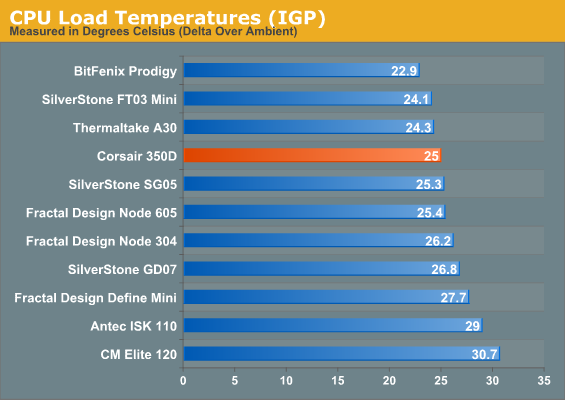

Thermally the Obsidian 350D puts in a fairly healthy performance. Competitive without being spectacular, it mostly suffers from being an offshoot of the basic ATX case design. Air cooling thermals have never been Corsair's strong suit, but they've always been workable, and the 350D continues that trend.


Because the 350D is able to keep thermals reasonably low, noise stays low as well. The vanilla testbed is nowhere near stressful enough to really work the 350D.
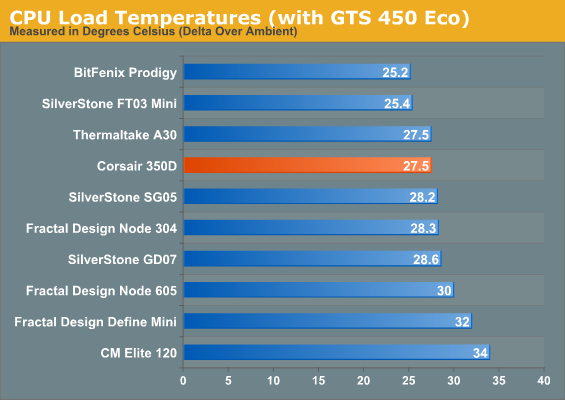
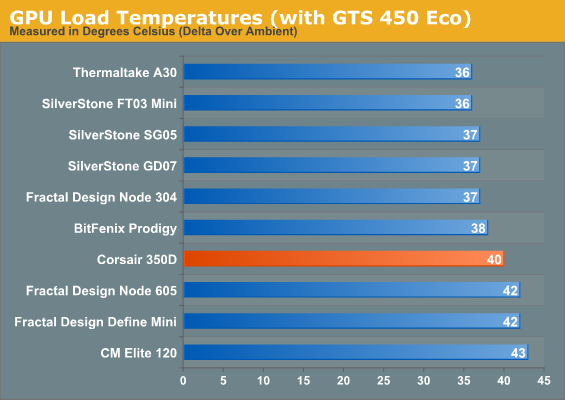
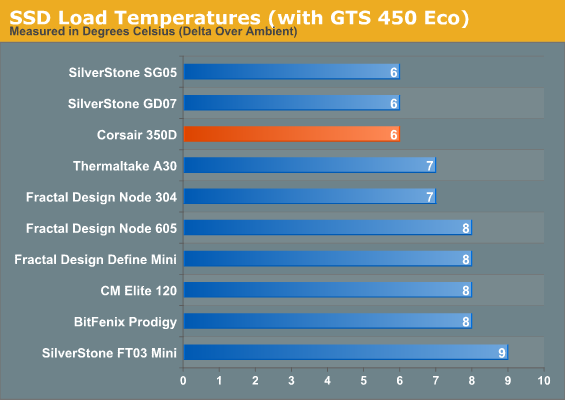
When you add even a modest dedicated graphics card, Corsair starts playing that old familiar song. The plastic "cage" used for the SSD doesn't seem to be particularly detrimental to its temperatures, but even the direct airflow from the front fan onto the GTS 450 Eco isn't really adequate. CPU thermals remain solid, though.
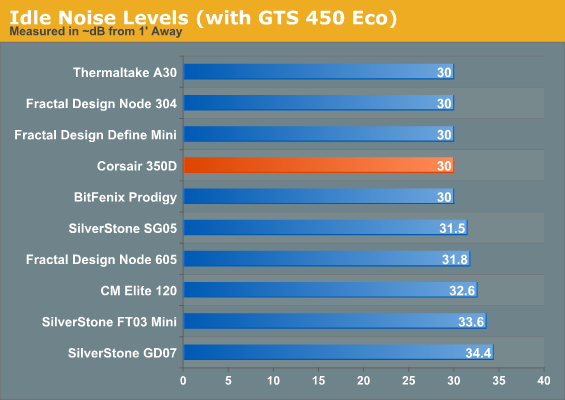
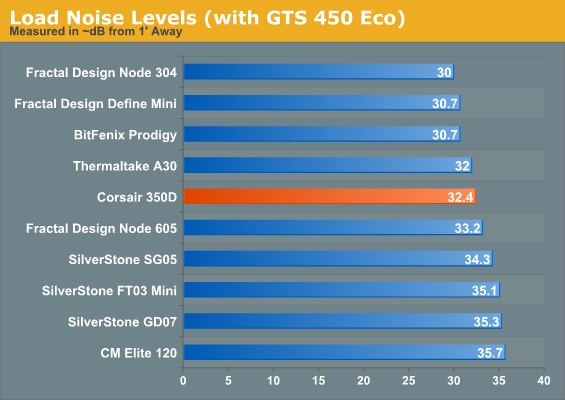
Idle noise continues to be a non-issue. Load noise isn't terrible, but it's not very impressive, either. While Fractal Design's case has a lot of acoustic padding and is built with heavy steel to help insulate noise, the 350D has no such allowances, and noise becomes entirely dependent on the efficiency of the cooling system.
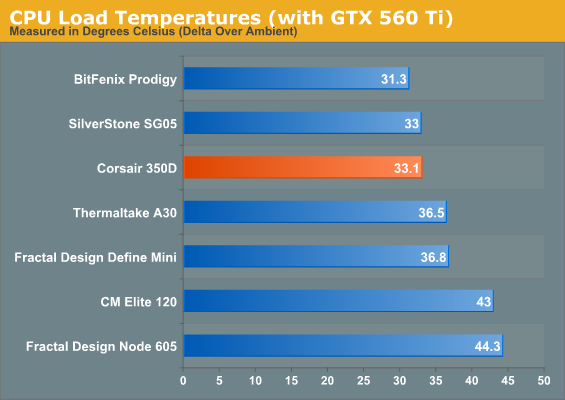
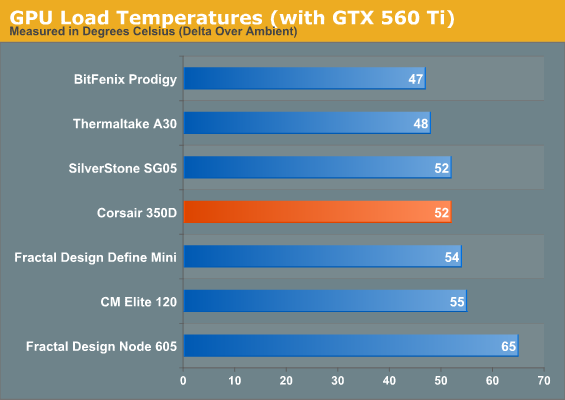
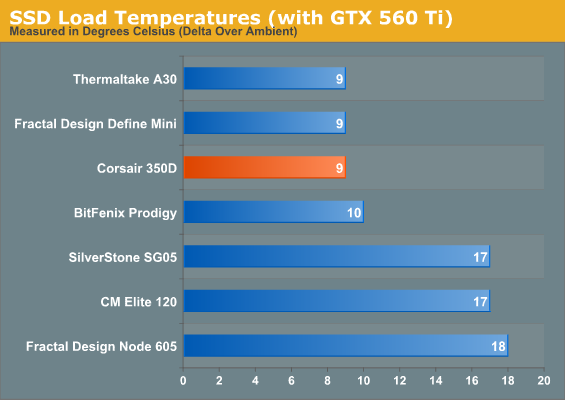
Adding a more robust video card only reinforces what we've already learned. CPU cooling performance is above average, but GPU cooling performance continues to be middling. These cards are using open air coolers that will tax the case's cooling system, and the middling stock cooling (one 140mm intake and one 120mm exhaust in their typical ATX locations) doesn't do the 350D any favors.
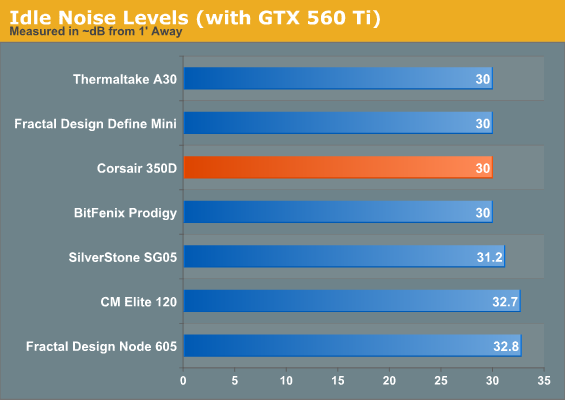

Noise levels are reasonable. The cooler on our GTX 560 Ti can be pretty rough on any enclosure (and is outright hostile when the 560 is overclocked), but at least the 350D isn't getting overwhelmed.










65 Comments
View All Comments
bobbozzo - Thursday, April 25, 2013 - link
Maybe a black bowl would not be so visible?Thanks for the reviews!
Zap - Thursday, April 25, 2013 - link
Always good to see smaller-than-ATX cases given some attention. A lot to like about this Corsair case and I think all pertinent points have been made. I will point out, however, that this case seems pretty big for a mATX case. Of course coming from the company that just brought the world the 900D case, to be expected.I still feel that people aren't "getting" SFF (small form factor). The trend seems to be "how much crazy high end stuff can be built around a small motherboard" and not "how small an overall system can be achieved."
Rolphus - Thursday, April 25, 2013 - link
For "how small a system can be achieved", you've got Mini-ITX cases. For "how much gaming power can I pack into a box I can reasonably easily carry", I've got mATX ;)michaelheath - Thursday, April 25, 2013 - link
Rolphus, I think you're also missing the point.First: There are ATX cases that are smaller and more portable than this one. Just because you shaved 3 inches off the bottom of the motherboard doesn't mean you've somehow magically made the whole system lighter, especially if you stuff it full of high end hardware and cooling.
Second: There are mITX cases larger than some mATX cases. The Bit Fenix Prodigy is only marginally smaller than, say, the Fractal Design Mini, which is just silly. This is the reason why I think this case is silly: It's a stupid huge enclosure for a board that's not even a 10" square.
Third: The 350D weighs over 13 pounds *empty*. If you look, you'll find dimensionally smaller full ATX cases that weigh less than that at roughly the same price point.
The assumption made when creating mATX and mITX standards was that people wanted smaller systems. In fact, as devices become more powerful and less power hungry, there's actually *fewer* reasons to design cases like this. As someone looking to build a small, powerful gaming system that I can easily carry, I would't even begin to consider this case.
DanNeely - Thursday, April 25, 2013 - link
"As someone looking to build a small, powerful gaming system that I can easily carry, I would't even begin to consider this case."Nor would Corsair expect you to. Like the other recently reviewed mATX case; this one is targeted at people building high performance systems who've decided they don't need a full ATX board but who have otherwise not changed their building patterns. Just big enough to hold an mATX board cases and just big enough to hold a full ATX board cases (with a full ATX board installed) don't have room for anything beyond a 1x120/140mm closed loop rad. Fitting in 240/280mm rads; never mind the pumps/reservoirs needed for full custom loops needs a few inches of space beyond the minimum required to cram the board in. That's the group this case is aimed at; and it is significantly smaller than what they'd need for an equivalent full ATX system.
michaelheath - Thursday, April 25, 2013 - link
That logic can easily be defeated with the following statement:If you don't have enough equipment to fill up the slots of a full ATX board, you probably also don't have enough equipment to warrant water cooling.
DanNeely - Thursday, April 25, 2013 - link
Water cooling is quieter than air cooling whether you have 1 large GPU in your system or 4.Rolphus - Friday, April 26, 2013 - link
I've got an mATX system with 2 GTX 580s and an overclocked (closed-loop cooled) i5-2500K, and I'm very interested in exploring water cooling for the GPUs. If anything, having a mATX board makes this more relevant as I can't really get enough air between the GPUs to be comfortable.Rolphus - Friday, April 26, 2013 - link
You're right, I have missed the point being made. My apologies.For me, all I care about is something more "portable" than my old Antec P180 (which weighed a ton and didn't easily fit in the boot of my car) so even the larger mATX cases are interesting.
This is why I find the case market fascinating: everyone has their ideals :)
lmcd - Friday, April 26, 2013 - link
Hence the SG09 ;) got a 3960X and saving up for a new GFX card for it :D